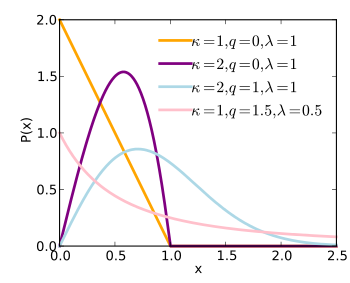q-Weibull distribution
|
Probability density function  | |||
|
Cumulative distribution function  | |||
| Parameters |
shape (real) rate (real) shape (real) | ||
|---|---|---|---|
| Support |
| ||
| CDF | |||
| Mean | (see article) | ||
In statistics, the q-Weibull distribution is a probability distribution that generalizes the Weibull distribution and the Lomax distribution (Pareto Type II). It is one example of a Tsallis distribution.
Characterization
[edit]Probability density function
[edit]The probability density function of a q-Weibull random variable is:[1]
where q < 2, > 0 are shape parameters and λ > 0 is the scale parameter of the distribution and
is the q-exponential[1][2][3]
Cumulative distribution function
[edit]The cumulative distribution function of a q-Weibull random variable is:
where
Mean
[edit]The mean of the q-Weibull distribution is
where is the Beta function and is the Gamma function. The expression for the mean is a continuous function of q over the range of definition for which it is finite.
Relationship to other distributions
[edit]The q-Weibull is equivalent to the Weibull distribution when q = 1 and equivalent to the q-exponential when
The q-Weibull is a generalization of the Weibull, as it extends this distribution to the cases of finite support (q < 1) and to include heavy-tailed distributions .
The q-Weibull is a generalization of the Lomax distribution (Pareto Type II), as it extends this distribution to the cases of finite support and adds the parameter. The Lomax parameters are:
As the Lomax distribution is a shifted version of the Pareto distribution, the q-Weibull for is a shifted reparameterized generalization of the Pareto. When q > 1, the q-exponential is equivalent to the Pareto shifted to have support starting at zero. Specifically:
See also
[edit]References
[edit]- ^ a b Picoli, S. Jr.; Mendes, R. S.; Malacarne, L. C. (2003). "q-exponential, Weibull, and q-Weibull distributions: an empirical analysis". Physica A: Statistical Mechanics and Its Applications. 324 (3): 678–688. arXiv:cond-mat/0301552. Bibcode:2003PhyA..324..678P. doi:10.1016/S0378-4371(03)00071-2. S2CID 119361445.
- ^ Naudts, Jan (2010). "The q-exponential family in statistical physics". Journal of Physics: Conference Series. 201 (1): 012003. arXiv:0911.5392. Bibcode:2010JPhCS.201a2003N. doi:10.1088/1742-6596/201/1/012003. S2CID 119276469.
- ^ Umarov, Sabir; Tsallis, Constantino; Steinberg, Stanly (2008). "On a q-Central Limit Theorem Consistent with Nonextensive Statistical Mechanics" (PDF). Milan Journal of Mathematics. 76: 307–328. doi:10.1007/s00032-008-0087-y. S2CID 55967725. Retrieved 9 June 2014.










![{\displaystyle e_{q}(x)={\begin{cases}\exp(x)&{\text{if }}q=1,\\[6pt][1+(1-q)x]^{1/(1-q)}&{\text{if }}q\neq 1{\text{ and }}1+(1-q)x>0,\\[6pt]0^{1/(1-q)}&{\text{if }}q\neq 1{\text{ and }}1+(1-q)x\leq 0,\\[6pt]\end{cases}}}](https://wikimedia.org/api/rest_v1/media/math/render/svg/4bde051d6ff2a26591683f8e2698aad8fd9796f4)


![{\displaystyle \mu (q,\kappa ,\lambda )={\begin{cases}\lambda \,\left(2+{\frac {1}{1-q}}+{\frac {1}{\kappa }}\right)(1-q)^{-{\frac {1}{\kappa }}}\,B\left[1+{\frac {1}{\kappa }},2+{\frac {1}{1-q}}\right]&q<1\\\lambda \,\Gamma (1+{\frac {1}{\kappa }})&q=1\\\lambda \,(2-q)(q-1)^{-{\frac {1+\kappa }{\kappa }}}\,B\left[1+{\frac {1}{\kappa }},-\left(1+{\frac {1}{q-1}}+{\frac {1}{\kappa }}\right)\right]&1<q<1+{\frac {1+2\kappa }{1+\kappa }}\\\infty &1+{\frac {\kappa }{\kappa +1}}\leq q<2\end{cases}}}](https://wikimedia.org/api/rest_v1/media/math/render/svg/f93a58bf0696cb2e7530ed63b89a818d8cdc6f06)





![{\displaystyle {\text{If }}X\sim \operatorname {{\mathit {q}}-Weibull} (q,\lambda ,\kappa =1){\text{ and }}Y\sim \left[\operatorname {Pareto} \left(x_{m}={1 \over {\lambda (q-1)}},\alpha ={{2-q} \over {q-1}}\right)-x_{m}\right],{\text{ then }}X\sim Y\,}](https://wikimedia.org/api/rest_v1/media/math/render/svg/08518f98bda4cb98bc57fc441e716f351966f504)